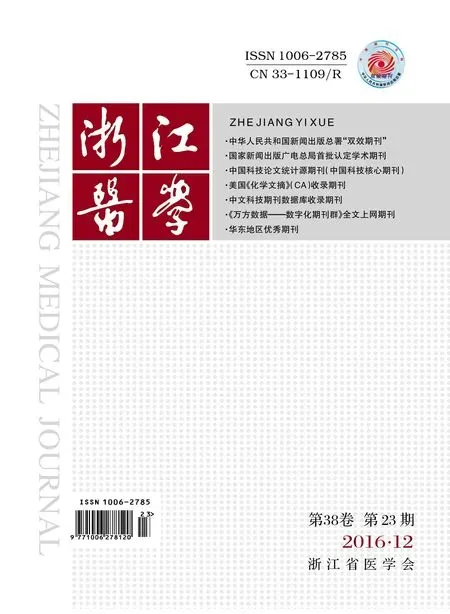PSAD对临床低危前列腺癌患者RP术后Gleason评分的预测价值
陈超 王鑫洪 林考兴 符二 李峰 盛茂 曹治列 何华东
PSAD对临床低危前列腺癌患者RP术后Gleason评分的预测价值
陈超 王鑫洪 林考兴 符二 李峰 盛茂 曹治列 何华东
目的 探讨前列腺特异性抗原密度(PSAD)对临床低危前列腺癌(PCa)患者根治性前列腺切除术(RP)后Gleason评分的预测价值。方法 回顾性分析102例经首次前列腺活检(PB)确诊且行RP术的临床低危PCa患者的临床资料(PSA<10μg/L,临床分期≤T2a,Gleason评分≤6分)。根据RP术后Gleason评分是否升高分为评分一致组48例与评分升高组54例,比较两组患者的临床资料;绘制ROC曲线并计算AUC,以确定PSAD预测RP术后Gleason评分升高的效能。结果 评分升高组PSAD为 0.310(0.190,0.408)mg/L2,明显高于评分一致组的 0.181(0.142,0.248)mg/L2(P<0.01);评分升高组 PV为 24.107(18.252,30.208)ml,明显小于评分一致组的30.129(22.617,40.538)ml(P<0.05);评分升高组病理分期、侵犯包膜阳性率均高于评分一致组(均P<0.01)。AUC为0.734(95%CI:0.636~0.832),PSAD预测首次PB时Gleason评分升高的截值为0.263mg/L2,其灵敏度和特异度分别为63.0%和85.4%。结论 PB确诊为临床低危PCa患者中,PSAD对RP术后Gleason真实评分具有较好的预测价值。
前列腺特异性抗原密度 Gleason评分 首次前列腺活检
在欧美国家,前列腺癌(PCa)是引起癌性死亡的第二常见原因[1]。在我国,PCa发生率相对较低,但随着人们寿命的延长、生活方式的改变和新诊断技术的应用而有所上升[2],PCa病死率呈增长趋势[3]。经长期随访发现临床低危PCa进展缓慢,病死患者多为中高级别PCa[4]。为避免过度治疗,越来越多的临床低危PCa患者选择主动监测[5]。前期研究发现前列腺活检(PB)时Gleason评分有相当一部分低于根治性前列腺切除术(RP)后[6],提示PB时Gleason评分并不能代表真实水平。目前已有多家中心报道前列腺特异性抗原密度(PSAD)可预测真实的Gleason评分[6-8],但尚存一定的争议。我国有关这方面的资料较少,尤其是对临床低危PCa患者,故笔者收集102例临床低危PCa患者的临床资料作一分析,以探讨PSAD对临床低危PCa患者RP术后Gleason评分的预测价值。
1 对象和方法
1.1 对象 收集2008年6月至2015年12月在杭州市第一人民医院以及中国人民解放军第一一七医院行RP术的102例临床低危PCa患者的临床病理资料。年龄46~79[70(63,72)]岁;前列腺特异性抗原(PSA)为1.612~9.950[6.470(5.240,8.699)]μg/L;前列腺体积(PV)为11.793~93.350[26.844(19.319,39.836)]ml;PSAD为0.030~0.645[0.237(0.151,0.349)]mg/L2;临床分期:T1期53例,T2期49例:RP术后病理分期:pT2期75例,pT3期22例,pT4期5例。入组标准:(1)在指定机构测定血PSA、行前列腺MRI和经直肠前列腺超声检查,且首次行PB即确诊为临床低危PCa患者(PSA<10μg/L,分期≤T2a,Gleason评分≤6分);(2)前列腺穿刺10针以上;(3)RP术前未作任何新辅助内分泌等治疗;(4)不存在如留置导尿、服用5α还原酶抑制剂等可能干扰PB前PSA水平的因素;(5)PB与RP间隔时间<3个月;(6)RP术后Gleason评分高于或等于PB时。
1.2 观察指标 收集患者年龄、PSA、PV、PSAD、临床分期、病理分期等指标。所有PV经直肠超声测定;PSAD= PSA/PV。
1.3 统计学处理 应用SPSS 19.0统计软件。计量资料用M[P25,P75]表示,连续性变量比较采用Mann-Whitney U检验;计数资料用率表示,分类变量比较采用Pearson χ2检验或Fisher确切概率法。绘制ROC曲线并计算AUC,以评价PSAD预测RP术后Gleason评分升高的效能。
2 结果
2.1 两组临床资料比较 根据RP术后Gleason评分是否升高分为评分一致组(48例)和评分升高组(54例)。两组患者PV、PSAD、病理分期、侵犯包膜等方面比较,差异均有统计学意义(均P<0.05),见表1。

表1 两组临床资料的比较
2.2 PSAD预测RP术后Gleason评分升高的效能 AUC为0.734(95%CI:0.636~0.832),PSAD预测首次PB时Gleason评分升高的截值为0.263mg/L2,其灵敏度和特异度分别为0.630和0.854,见图1。

图1 临床低危PCa患者PSAD预测首次PB时Gleason评分是否升高的ROC曲线
3 讨论
PCa治疗方案取决于肿瘤分期、分级以及一些影响预后的因素。对于临床低危PCa患者可以选择主动监测,并非需要立即行RP术。但应注意的是,仍有相当一部分经PB评估的患者在RP术后出现Gleason评分升高或分期升级[9]。Cohen等[10]报道与PB时比较,RP术后有6%~36%的PCa患者Gleason评分升高,其中Gleason评分≤6分者,这个比例可达50%。Corcoran等[7]回顾性分析1 516例患者临床资料指出PB时Gleason评分为3+3及3+4的PCa患者在RP术后Gleason评分升高的比例分别为58.3%和26.2%;提示PB时Gleason评分越低,术后评分升高的可能性越大。这可能会延误倾向选择主动监测且Gleason评分3+3的PCa患者病情,因此在临床上需要更准确地判断PCa的危险等级。
目前PSAD一般用于筛选PSA<10μg/L情况下的可疑PCa患者,它与PV相关,可能具有预测术后Gleason评分的能力。Magheli等[8]发现Gleason评分3+3的患者治疗前PSAD是预测术后Gleason评分升高的重要因素,AUC为0.567(95%CI:0.531~0.602),并提出0.23mg/L2可作为PSAD判断术后Gleason评分是否升高的截值,其灵敏度和特异度分别为53.6%和64.1%。笔者前期研究发现在Gleason评分3+3的患者中,PSAD具有预测术后Gleason评分升高的能力,但随着Gleason评分的升高,PSAD预测能力有所下降[6]。本研究进一步证实PSAD对临床低危PCa患者RP术后Gleason评分升高具有重要预测作用,评分升高组患者PSAD高于评分一致组。此外,根据ROC曲线计算AUC为0.734(95%CI:0.628~0.826),PSAD的截值为0.263mg/L2,其灵敏度和特异度分别为0.630和0.854。本研究结果显示,在PSA<10μg/L的临床低危PCa患者中,评分升高组与评分一致组术前PSA比较差异无统计学意义,不具备准确评估PCa危险等级的能力。Aihara等[11]对5个不同病理结构类型的PCa标本染色,发现随着Gleason评分升高,PSA分泌能力下降。笔者认为PSAD比PSA更具有预测价值,原因可能与PV有关。本研究发现评分升高组患者PV小于评分一致组,提示在相同PSA的情况下,PV偏小可能是Gleason评分升高的危险因素。Oh等[12]回顾性分析505例经多点穿刺(>12针)且Gleason评分为6分的PCa患者临床资料,指出PSAD比PSA更能准确预测术后真实的Gleason评分,原因可能与PV有关;并在研究中指出RP术后Gleason评分升高患者的PV小于评分一致的患者。Sfoungaristos等[13]回顾性分析302例PCa患者发现PSA与PB时、RP术后Gleason评分的改变无明显相关性,但在PB时Gleason评分≤6分的患者中,PV较小、PSAD升高与RP术后Gleason评分升高明显相关。Yashi等[14]回顾性分析170例临床低危PCa患者发现PV较大者RP术后的病理分期、Gleason评分较好,提示PV<35.5ml是个危险因素。此外,本研究提示评分升高组患者的病理分期高于评分一致组,与相关研究结果一致。Eroglu等[15]研究表明评分升高组切缘阳性率、包膜侵犯阳性率、前列腺周侵犯阳性率均明显高于评分一致组;Corcoran等[16]研究表明评分升高组病理分期更高,RP术后复发风险较高,并指出Gleason评分比其他指标更能准确反映疾病特征。但两组患者侵犯精囊阳性率比较,差异无统计学意义,可能与本研究严格的入选标准有关。
目前根据血PSA、PB时Gleason评分和临床分期判定的临床低危PCa患者,越来越多选择主动监测作为治疗方法[17]。但是仍有一部分临床低危PCa患者在RP术后发现病理特征较差[18];因此,提高这部分临床低危PCa的识别能力是关键。本研究提示PSAD对临床低危PCa患者RP术后真实Gleason评分具有较好的预测能力,PV偏小是RP术后Gleason评分升高的不利因素;这对于选择主动监测的临床低危PCa患者具有积极的参考意义。
[1]Siegel R,Ma J,Zou Z,et al.Cancer statistics,2014[J].CA:a cancer journalfor clinicians,2014,64(1):9-29.
[2]Hu Y,Zhao Q,Rao J,et al.Longitudinal trends in prostate cancer incidence,mortality and survival of patients from two Shanghai city districts:a retrospective population-based cohort study, 2000-2009[J].BMC public health,2014,14(1):356.
[3]韩苏军,张思维,陈万青,等.中国前列腺癌死亡现状及流行趋势分析[J].中华泌尿外科杂志,2012,33:836-839.
[4]Crawford ED,Grubb R,BlackA,etal.Comorbidityand mortalityresults from a randomized prostate cancer screening trial[J].JournalofClinicalOncology,2011,29(4):355-361.
[5]Cooperberg M R,Carroll P R,Klotz L.Active surveillance for prostate cancer:progress and promise[J].Journalof ClinicalOncology,2011,29(27):3669-3676.
[6]陈超,谢立平,郑祥毅,等.前列腺特异性抗原密度预测首次前列腺活检标本Gleason评分升高的价值[J].中华泌尿外科杂志,2013,34 (10):755-759.
[7]Corcoran NM,Casey RG,Hong MK,et al.The ability ofprostatespecific antigen(PSA)density to predict an upgrade in Gleason score between initial prostate biopsy and prostatectomy diminishes with increasing tumour grade due to reduced PSA secretion per unit tumour volume[J].BJU Int,2012,110:36-42.
[8]MagheliA,Hinz S,Hege C,et al.Prostate specific antigen density to predict prostate cancer upgrading in a contemporary radical prostatectomy series:a single center experience[J].J Urol,2010, 183:126-131.
[9]Jalloh M,Myers F,Cowan J E,et al.Racial variation in prostate cancer upgrading and upstaging among men with low-risk clinicalcharacteristics[J].European urology,2015,67(3):451-457.
[10]Cohen MS,Hanley R S,Kurteva T,et al.Comparing the Gleason prostate biopsy and Gleason prostatectomy grading system:the Lahey Clinic Medical Center experience and an international meta-analysis[J].Eur Urol,2008,54:371-381.
[11]Aihara M,Lebovitz R M,Wheeler TM,et al.Prostate specific antigen and gleason grade:an immunohistochemical study ofprostate cancer[J].The Journalofurology,1994,151(6):1558-1564.
[12]Oh J J,Hong S K,Lee J K,et al.Prostate-specific antigen vs prostate-specific antigen density as a predictor of upgrading in men diagnosed with Gleason 6 prostate cancer by contemporary multicore prostate biopsy[J].BJU Int,2012:1-6.
[13]Sfoungaristos S,Perimenis P.Clinical and pathological variables that predict changes in tumour grade after radical prostatectomy in patients with prostate cancer[J].CUAJ,2013,7:E93-E97.
[14]YashiM,Mizuno T,YukiH,et al.Prostate volume and biopsy tumor length are significant predictors for classical and redefined insignificant cancer on prostatectomy specimens in Japanese men with favorable pathologic features on biopsy[J].BMC urology,2014,14(1):43.
[15]Eroglu M,Doluoglu O G,Sarici H,et al.Does the time from biopsy to radicalprostatectomy affect Gleason score upgrading in patients with clinical t1c prostate cancer?[J].Korean journal of urology,2014,55(6):395-399.
[16]Corcoran N M,Hong M K,Casey R G,et al.Upgrade in Gleason score between prostate biopsies and pathology following radi-cal prostatectomy significantly impacts upon the risk of biochemicalrecurrence[J].BJU Int,2011,108:E202-E210.
[17]Cooperberg MR,CarrollP R,Klotz L.Active surveillance for prostate cancer:progress and promise[J].J Clin Oncol,2011,29: 3669-3676.
[18]Mitsuzuka K,Narita S,Koie T,et al.Pathological and biochemical outcomes after radical prostatectomy in men with low-risk prostate cancer meeting the Prostate Cancer International:Active Surveillance criteria[J].BJU Int,2013,111:914-920.
Value of prostate-specific antigen density to predict risk level of prostate cancer
CHEN Chao,WANG Xinhong,LIN Kaoxing,et al.Department of Urology,Hangzhou First People's Hospital,Hangzhou 310006,China
Objective To evaluate the application of PSAD in prediction of Gleason score in patients with low risk prostate cancers(PCa)after radical prostatectomy(RP). Methods Clinical data of 102 PCa patients with low risk(PSA<10μg/L,stage≤T2a,Gleason score≤6)who underwent preoperative biopsy and RP were retrospectively analyzed.Receiver operating characteristic (ROC)curves of PSAD for predicting rising Gleason scores were generated,and the area under the curve(AUC) was calculated. Results Among 102 patients,54(52.9%)had risen Gleason score after operation.PSAD was significantly higher in patients with risen Gleason score after RP than that in patients with Gleason score not changed(0.310mg/L2vs 0.181mg/L2, P=0.000).The pathologic stages in patients with risen Gleason were more advanced(P=0.000).The AUC of ROC was 0.734(95% CI:0.636-0.832).Taking 0.263mg/L2as cut-off value,the sensitivity and specificity of PSAD in predicting Gleason score rising were 63.0%and 85.4%,respectively. Conclusion PSAD has the value of predicting Gleason score rising after RP in PCa patients with low clinical risk.
Rostate-specific antigen density Gleason score Prostate biopsy
2016-02-22)
(本文编辑:陈丹)
浙江省医药卫生科技项目(201484483)
310006 杭州市第一人民医院泌尿外科(陈超、何华东);中国人民解放军第一一七医院泌尿外科(王鑫洪、林考兴、符二、李峰、盛茂、曹治列)
何华东,E-mail:andy-2222@163.com

